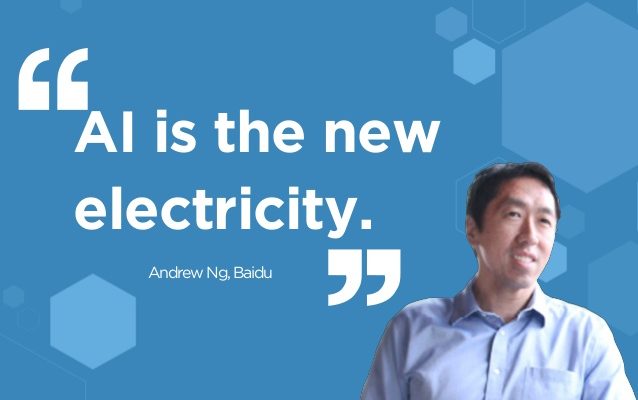“Just as 100 years ago electricity transformed industry after industry, AI will now do the same.” – Andrew Ng, Coursera Founder, former Baidu Chief Scientist, AI Pioneer
Artificial Intelligence – it’s on the lips of the leaders, and on the 2018 agendas of the board meetings, of almost every global company today. Directors and operating executives alike know, or think they know, that this “new electricity” is going to be the next transformative force of our world. To ignore it now could be fatal to their long-term competitive position, not to mention survival.
AI-powered companies that know what they are doing — primarily born in the Internet and mobile eras — have not only gained tremendous advantage in improved efficiency and increased profitability, they have literally changed the competitive landscape of successive industries. And they are continuing to do so, as they venture into new fields, challenging a whole new set of incumbents that are not AI “natives.” (Witness Google’s Launchpad Studio’s focus on healthcare AI startups, and Alphabet’s Waymo autonomous cars, to name only two.)
Extreme Hype
Yet, the hype – and pressure to adopt – have gotten extreme, just as the supply of human expertise has become limited. The top 8 technology companies – Google, Facebook, Microsoft, Amazon, IBM, Baidu, Tencent, and Alibaba – light years beyond others in AI adoption and implementation, are cornering the available talent in the industry through direct lines of recruitment at the world’s top universities, and by acquiring a steady stream of young, forward-looking start-ups.
So, while it is all well and good for leaders to know that they must get into the game, to not miss the momentum and remain competitive, tremendous time and money are also being wasted through ill-advised, or non-strategic, forays into AI: witness MD Anderson’s noble but unsuccessful mission to “eradicate cancer” through artificial intelligence – at a cost of $62 million.
Playbook For The Top-Of-The-House
What follows in this article, and successive pieces, is our expert version of a playbook for the top-of-the-house on how to better understand the potential of AI to transform your business, and how to plot its implementation in a powerful, strategic, and winning way.
Winner Takes All
What everyone is worried about, of course, is that AI will become a winner-take-all play. Like the poor buggy-whip makers of old, if businesses and organizations don’t adapt, they may well become extinct.
The disruptive edge AI is providing to various players across industries comes through 3 primary means:
Predictive Analytics, Diagnostics and Recommendations are changing the game in financial services, digital media and e-commerce, for large companies and small. Japanese insurance firm Fukoku Mutual Life replaced its 34-member workforce with IBM’s Watson Explorer AI to calculate insurance policy payouts, resulting in an increase in productivity of 30%, and savings of approximately $1.3 million a year. Digital media companies such as Spotify, Amazon, Pandora and Netflix have been using various machine learning algorithms and predictive analytics models such as “user and content-based collaborative filtering” and “frequency items mining” for their recommendation engines — Amazon for over a decade. And, e-commerce players across the world, ranging from Amazon to Blibli.com, use machine learning algorithms for dynamic price optimization — correlating pricing trends with sales trends, then aligning them with other factors such as category management and inventory levels, in order to increase average spend per user, and therefore net revenues.
Early AI products such as Chatbots, Intelligent Voice Assistants, and Conversational AI, such as Alexa are revolutionizing every aspect of the customer experience, including financial institutions, healthcare, retail and travel. These computer programs are designed to conduct human-like (back-and-forth) conversations through auditory or textual methods, and are primarily used for customer service and information gathering. Chatbots evolved primarily on the back of Internet Messenger platforms, hitting an inflection point in 2016. As of mid-2016, more than 11,000 Facebook Messenger bots and 20,000 Kik (South Korean Mobile Internet Messenger) bots had been launched. As of April, 2017, 100,000 bots had been created for Facebook Messenger alone. Currently chatbots are rapidly proliferating in the consumer space, with capabilities to handle multiple tasks, including shopping, travel search and bookings, payments, office management, customer support, and task management, to name a few.
Rapid Changes in Visual Machine Learning, Such as Image Recognition, Medical Diagnostics, Security, and Real-Time Video, particularly are critical for autonomous driving. In 2012, Google ran a deep learning experiment in which it presented 10 million video-derived “thumbnail” pictures to a highly connected neural net with a billion plus connections. The training was unsupervised, meaning there were no identifiers on the pictures. Yet, the net learned the patterns of elements in the thumbnails, and made its own associations. It learned to identify certain objects even though it wasn’t trained on them, such as human faces – it just needed to know what to call them. Interestingly, it did quite well with cats, too!
Today, AI can learn to recognize various images after being trained with approximately 1000 labeled pictures. For certain applications, methods such as “one-shot,” or “few-shot,” may require far fewer pictures. The requirements of real-time, motion and scene understanding are rapidly pushing the boundaries of hardware and software, as autonomous driving becomes a reality.
So, What Must The Board And C-Suite Consider?
There’s no room for organizations or their leaders to not be fully up to speed on AI, Machine Learning, and Deep Learning. Following are our suggestions on how to proceed, strategically, competitively, and operationally, in 2018 and beyond:
- Every leader needs at least an initial immersion into AI, Machine Learning, and Deep Learning, and their implications for business, offered as a separate training or bespoke tutorial.
- They need to take a deep dive into best practices in their industry: what is possible now, what will be possible, what direct and indirect competitors are doing, and what other industries are doing that could translate to our business to give us a leg up?
- Leaders need to be asking whether they have the right talent onboard, across the board – because vision and strategy may come from the highest levels of the organization and board, while innovation and implementation will need to be widespread across the organization.
- Further, efforts can not be siloed: they need to be cross-functional, across leadership levels, collaborative, and highly knowledgeable. They require a synthesis of AI expertise, domaine knowledge, business acumen, and corporate strategy and vision.
- Trust and buy-in at the top are hard to marshal in such a fast-evolving technological environment. The need to find trusted advisors to guide next steps — experts who speak their language, and keep pace with AI’s rapid growth as the field reaches and exceeds successive tipping points — has turned into an imperative.
- Because, indeed, it is critical to get started now, but in the right ways and at the right scale, in order to enable success. And for that, the board, executive leadership, and those tasked with innovation and implementation must all be in strategic and tactical alignment.
Rapidly Accelerating Time Line
As our timeline shows so well, and we are all observing real-time, the AI inflection point is here. For over six decades, since the early 1950’s, AI has been studied in universities and labs. But it is only in the last five years that AI development and deployment has hit a tipping point. Many drivers have contributed to this disruption: ubiquitous computing, low-cost cloud services, nearly unlimited inexpensive storage, new algorithms, cloud computing, and advances in Graphical Processing Units (GPU’s). Of all these drivers, three recent breakthroughs have fueled the arrival of AI – the rise of parallel computing, the availability of big data, and improved AI algorithms.
And more breakthroughs are on the way: while still in its infancy, quantum computing promises to disrupt and create wholly new AI applications because of its greatly accelerated compute speed. For example, the enormous task of optimizing real-time, second-by-second vehicle navigation through a large city is currently impossible. But, with quantum computing this can be achieved, and it will be necessary for the coming era of autonomous vehicles, whether on the ground or in the air. Similar examples can be imagined in every industry.
Changing Entire Business Models
But it is the leaders of our companies and organizations who will decide how it will all unfold, as well as who will win, who will lose, and who will stagnate. AI can go beyond changing business processes to changing entire business models. It is our task to help organizations plot the future, build centralized AI functions with multi-disciplinary and cross-functional expertise, and align them with business growth strategies and governance.
Cognitizing
AI is fast turning out to be the key utility of the technology world. And like all utilities, it will enliven most inert objects, much as electricity did a century ago. With AI, everything that we formerly electrified, we will now “cognitize.”
And that is enough to boggle our artificial and human minds, alike!
Davia Temin, CEO of leadership and governance strategy firm Temin & Company, helps create, enhance and save reputations at board and executive levels. She is also an Advisor to SpringBoard.ai. Twitter: @DaviaTemin
Bruce Molloy has been an innovator and leader in AI, Machine Learning and Deep Learning for over 20 years. A serial entrepreneur, he has founded multiple AI companies, including SpringBoard.ai
Jayanth Kolla is a strategy consultant to the world’s leading corporations and investors on emerging technologies and digital transformation He is an Advisor to SpringBoard.ai.
Source: https://www.forbes.com/




